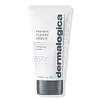What's inside
What's inside
 Key Ingredients
Key Ingredients

 Benefits
Benefits

 Concerns
Concerns

 Ingredients Side-by-side
Ingredients Side-by-side

Water
Skin ConditioningSimmondsia Chinensis Seed Oil
EmollientGlycerin
HumectantSorbitol
HumectantStearic Acid
CleansingCocamidopropyl Hydroxysultaine
CleansingCaprylic/Capric Triglyceride
MaskingDimethicone
EmollientSaccharide Isomerate
HumectantSorbitan Stearate
EmulsifyingGlyceryl Stearate
EmollientPEG-100 Stearate
Butyrospermum Parkii Butter
Skin ConditioningCetearyl Alcohol
EmollientCeteareth-20
CleansingCetyl Alcohol
EmollientMangifera Indica Seed Butter
Skin ConditioningMethylglucoside Phosphate
Skin ConditioningCopper Lysinate/Prolinate
Skin ConditioningAllantoin
Skin ConditioningDipotassium Glycyrrhizate
HumectantAlgae Extract
EmollientArtemisia Vulgaris Extract
Skin ConditioningCorallina Officinalis Extract
Skin ConditioningCamellia Sinensis Leaf Extract
AntimicrobialPhenoxyethanol
PreservativeCaprylyl Glycol
EmollientEthylhexylglycerin
Skin ConditioningHexylene Glycol
EmulsifyingBenzyl Alcohol
PerfumingMagnesium Aluminum Silicate
AbsorbentXanthan Gum
EmulsifyingDisodium EDTA
Water, Simmondsia Chinensis Seed Oil, Glycerin, Sorbitol, Stearic Acid, Cocamidopropyl Hydroxysultaine, Caprylic/Capric Triglyceride, Dimethicone, Saccharide Isomerate, Sorbitan Stearate, Glyceryl Stearate, PEG-100 Stearate, Butyrospermum Parkii Butter, Cetearyl Alcohol, Ceteareth-20, Cetyl Alcohol, Mangifera Indica Seed Butter, Methylglucoside Phosphate, Copper Lysinate/Prolinate, Allantoin, Dipotassium Glycyrrhizate, Algae Extract, Artemisia Vulgaris Extract, Corallina Officinalis Extract, Camellia Sinensis Leaf Extract, Phenoxyethanol, Caprylyl Glycol, Ethylhexylglycerin, Hexylene Glycol, Benzyl Alcohol, Magnesium Aluminum Silicate, Xanthan Gum, Disodium EDTA
Water
Skin ConditioningEthylhexyl Hydroxystearate
EmollientButylene Glycol
HumectantCetearyl Ethylhexanoate
EmollientCetyl Caprylate
EmollientStearic Acid
CleansingPEG-8
HumectantOctyldodecanol
EmollientDimethicone
EmollientGlyceryl Stearate Se
EmulsifyingPEG-100 Stearate
Sodium Hyaluronate
HumectantHydrolyzed Sodium Hyaluronate
Skin ConditioningSodium Ascorbyl Phosphate
AntioxidantChlorella Vulgaris Extract
Skin ConditioningCeramide NP
Skin ConditioningPhytosterols
Skin ConditioningCentella Asiatica Extract
CleansingLinoleic Acid
CleansingEchinacea Purpurea Extract
MoisturisingAloe Barbadensis Extract
Skin ConditioningPalmitic Acid
EmollientMyristic Acid
CleansingRosa Centifolia Extract
Skin ConditioningLactic Acid
BufferingLinolenic Acid
CleansingPropanediol
SolventTocopherol
AntioxidantPotassium Cetyl Phosphate
EmulsifyingHelianthus Annuus Seed Oil
EmollientTetrasodium Glutamate Diacetate
Ethylhexylglycerin
Skin ConditioningCetyl Alcohol
EmollientCarbomer
Emulsion StabilisingHydroxystearic Acid
CleansingAminomethyl Propanol
BufferingSodium Hydroxide
BufferingPhenoxyethanol
PreservativeWater, Ethylhexyl Hydroxystearate, Butylene Glycol, Cetearyl Ethylhexanoate, Cetyl Caprylate, Stearic Acid, PEG-8, Octyldodecanol, Dimethicone, Glyceryl Stearate Se, PEG-100 Stearate, Sodium Hyaluronate, Hydrolyzed Sodium Hyaluronate, Sodium Ascorbyl Phosphate, Chlorella Vulgaris Extract, Ceramide NP, Phytosterols, Centella Asiatica Extract, Linoleic Acid, Echinacea Purpurea Extract, Aloe Barbadensis Extract, Palmitic Acid, Myristic Acid, Rosa Centifolia Extract, Lactic Acid, Linolenic Acid, Propanediol, Tocopherol, Potassium Cetyl Phosphate, Helianthus Annuus Seed Oil, Tetrasodium Glutamate Diacetate, Ethylhexylglycerin, Cetyl Alcohol, Carbomer, Hydroxystearic Acid, Aminomethyl Propanol, Sodium Hydroxide, Phenoxyethanol
 Reviews
Reviews

Ingredients Explained
These ingredients are found in both products.
Ingredients higher up in an ingredient list are typically present in a larger amount.
Cetyl Alcohol is a fatty alcohol. Fatty Alcohols are most often used as an emollient or to thicken a product.
Its main roles are:
Though it has "alcohol" in the name, it is not related to denatured alcohol or ethyl alcohol.
The FDA allows products labeled "alcohol-free" to have fatty alcohols.
Learn more about Cetyl AlcoholDimethicone is a type of synthetic silicone created from natural materials such as quartz.
What it does:
Dimethicone comes in different viscosities:
Depending on the viscosity, dimethicone has different properties.
Ingredients lists don't always show which type is used, so we recommend reaching out to the brand if you have questions about the viscosity.
This ingredient is unlikely to cause irritation because it does not get absorbed into skin. However, people with silicone allergies should be careful about using this ingredient.
Note: Dimethicone may contribute to pilling. This is because it is not oil or water soluble, so pilling may occur when layered with products. When mixed with heavy oils in a formula, the outcome is also quite greasy.
Learn more about DimethiconeEthylhexylglycerin (we can't pronounce this either) is commonly used as a preservative and skin softener. It is derived from glyceryl.
You might see Ethylhexylglycerin often paired with other preservatives such as phenoxyethanol. Ethylhexylglycerin has been found to increase the effectiveness of these other preservatives.
Peg-100 Stearate is an emollient and emulsifier. As an emollient, it helps keep skin soft by trapping moisture in. On the other hand, emulsifiers help prevent oil and water from separating in a product.
PEGS are a hydrophilic polyether compound . There are 100 ethylene oxide monomers in Peg-100 Stearate. Peg-100 Stearate is polyethylene glycol ester of stearic acid.
Phenoxyethanol is a preservative that has germicide, antimicrobial, and aromatic properties. Studies show that phenoxyethanol can prevent microbial growth. By itself, it has a scent that is similar to that of a rose.
It's often used in formulations along with Caprylyl Glycol to preserve the shelf life of products.
Stearic Acid is a fatty acid. It is an emollient, emulsifier, and texture enhancer.
As an emollient, stearic acid helps soften skin. It aids the skin's protective barrier by preventing water loss. It also provides a gentle cleansing effect without stripping away natural oils.
Stearic acid may also be used to enhance the texture of products. It can add volume and stabilize ingredients such as water and oil. This can help water and oil ingredients from separating.
Sources of stearic acid include animal or vegetable fats/oils such as coconut or shea. It can be naturally found in butter, cocoa butter, shea butter, vegetable fats, and animal tallow.
This ingredient may not be Malassezia folliculitis, or fungal-acne safe.
Learn more about Stearic AcidWater. It's the most common cosmetic ingredient of all. You'll usually see it at the top of ingredient lists, meaning that it makes up the largest part of the product.
So why is it so popular? Water most often acts as a solvent - this means that it helps dissolve other ingredients into the formulation.
You'll also recognize water as that liquid we all need to stay alive. If you see this, drink a glass of water. Stay hydrated!
Learn more about Water